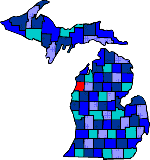|
It is believed that this county was first explored by Frenchmen.
Pioneers from Massachusetts built a wooden blockhouse in the 1830's on the Manistee river, but
they abandon this when they were forced out by Native Americans. In 1836 with the Treaty of Washington, Michigan
Native Americans transferred the northwest lower peninsula to the US Government. 70,000 acres were set aside for their
reservation at the mouth of the Manistee River. The reservation at a later date moved to the Grand Traverse area.
The first sawmill was constructed by the white settlers in 1840, marking the beginning of the lumbering trade. In October 1871 a fire destroyed the city, and by 1873 the city began to flourish again.
In the 1880's the logging industry was an important factor for the growth of this county. The last saw mill was closed in 1925, and
the salt mines and fruit farms began to bring income back into the area. In the 1930's the Civilian Conservation Corps replanted the area establishing the Manistee National Forest.
Today the county is a leader in salt production, as well as producing apples.
|

